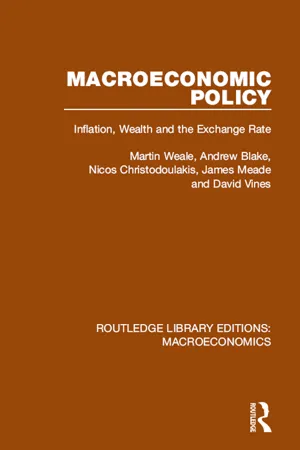![]()
Part I
Theory
![]()
Chapter One
A New Keynesian framework for macroeconomic policy
1.1 AN OVERVIEW OF THE IDEAS IN THIS BOOK
1.1.1 New Keynesian financial policy: objectives and instruments
We propose in this study what we call a New Keynesian assignment of fiscal and monetary policies. In the Old or Orthodox Keynesian prescription it was the function of financial policies to maintain a high and stable level of real demand for the United Kingdom’s products and so for the level of employment; and in so far as this threatened to lead to an inflation of money costs and prices, it was the function of the reform of wage- and price-setting institutions (incomes policy) to prevent this. In our New Keynesian system this prescription is reversed. We propose that the function of fiscal and monetary policies should be to prevent monetary inflation by maintaining the level of total monetary expenditures on the country’s products (the Money GDP) on a steady stable growth path; it would then become the function of structural reform of wage-setting and price-fixing institutions to ensure that, so long as there are unemployed resources available, increased money expenditures lead to an increase in real output and employment at uninflated levels of money costs and prices rather than to a rise in the money wages and prices of the existing levels of employment and output. This Money GDP target is the centrepiece of our proposals.
In addition, we argue that the Money GDP target should not be the sole objective of fiscal and monetary policy. Policy-makers face an understandable temptation to control inflation through policies which reduce inflationary pressures by raising current living standards at the expense of future living standards. We advocate the use of a target value for national wealth concurrently with a target value for Money GDP, as a means of preventing this.
In this book we propose financial policy rules – for both fiscal and monetary policy – which steer both Money GDP and national wealth to target values. We argue that both sets of policies should share in the pursuit of both objectives. The design of financial policy needs to consider all of the relevant linkages – from each target to each instrument. And policy-makers should, we argue, adopt what we call the right instrument-target emphasis in policy choice – a relative weight on each of the objectives of policy which reflects the structure of the economy – when they set each of the instruments of policy.
1.1.2 The labour market
We shall see that particularly if wages are strongly indexed to prices, and thus if real wages are sticky, the temptation for the authorities to buy out inflation at the expense of wealth will be strong. For example, if real wages are sticky a real exchange-rate appreciation will be attractive as a means of reducing inflationary pressures, despite the fact that it reduces both domestic and foreign investment. We seek to design policy rules which will take account of such dangers, and argue that the appropriate form for these rules is determined by the structure of the economy and in particular by the extent of wage-price indexation observed in the labour market.
More generally we seek to explore systematically the connections between financial policy and labour market behaviour and the implications of labour market behaviour for the design of financial policy. Our second major contribution thus concerns the crucial importance of the structure of the labour market for the design of both monetary policy and fiscal policy. We show that different types of policy rules must be designed, depending on whether wages are indexed or unindexed, at least on the basis of the plausible assumption which we make, namely, that fiscal policy has to be carried out by variations in tax rates.
1.1.3 An exchange-rate intermediate target
Our book has a third objective. Intermediate targets can provide a useful guide for short-term policy-making. Movements in the money stock have at times been used as a guide to indicate the appropriate setting of the short-term interest rate. However, more recently the use of the money stock as an intermediate target has become less popular. This is partly a consequence of the practical difficulties of monetary control. It is also partly because the use of the money stock as an intermediate target has led policy-makers to set interest rates at levels which have had undesirable and unintended effects on the exchange rates (cf. Poole, 1970, Dornbusch, 1976, Artis and Currie, 1981, Buiter and Miller, 1982).
Increasingly the exchange rate has been adopted as an intermediate target of policy. This need not necessarily imply that policy-makers aim to stabilize exchange rates at levels fixed either in nominal or in real terms. A more flexible use of the exchange rate as an intermediate target can be achieved if a rule is specified indicating how this target is to be set. Within such a context the operation of monetary policy requires another set of rules (i.e. for the interest rate and for foreign-exchange market intervention) in order to guide the actual exchange rate to its target value. The third aim of this book is to describe the use of the exchange rate as an intermediate target in this fashion.
Thus the financial policy rules to be studied in this book examine the pursuit of targets for Money GDP and national wealth when, in the conduct of monetary policy,
i) | monetary policy steers the exchange rate to its target, |
ii) | the exchange-rate target is not fi... |
